The American Rescue Plan
The nation is now more than a year in to the COVID-19 pandemic, a disaster that touched every corner of Americans’ lives at work and at home.
While relief from the virus in the form of widespread vaccination is on the horizon, it will still take a massive effort to help workers and their families recover from the devastation of the past year.
This will require producing and distributing more vaccines to facilitate access for all Americans as quickly as possible. It will also mean building a firm economic foundation so that working families have a chance at a brighter future.
On March 11, President Biden signed the American Rescue Plan, legislation that is historic for its breadth and ambition but more importantly because, unlike previous stimulus efforts, the direct beneficiaries of this legislation are working families.
The package is rightly getting a great deal of attention for the direct payments of up to $1,400 to lower- and middle-income Americans, but it also accomplishes much more, providing aid on a variety of fronts that will help keep workers safe and secure now and into the future.
For a downloadable PDF flyer with this information click here for color | black and white.
Public Health
The American Rescue Plan provides:
- $48.3 billion for testing, contact tracing and personal protective equipment (PPE)
- $7.5 billion for vaccine distribution
- $5.2 billion for procurement of vaccines and supplies
- $10 billion to expand domestic production of PPE, vaccines and medical supplies under the Defense Production Act
It’s clear that there is no way for our country to get back on track until the virus is under control. Accelerating the pace of vaccine production and distribution is vital to this effort
Until all Americans have access to the vaccine, it will remain necessary to continue with other disease mitigation efforts. This includes testing, PPE for frontline workers, contact tracing and more.
As we confront this crisis, it’s vital that we produce as much as we can domestically.
Utilizing the Defense Production Act will ensure that we’re producing essential goods as efficiently as possible here at home, and help rebuild our domestic security infrastructure.
The package also includes support for rural health-care providers to help ensure widespread access to needed health care, and additional funding for skilled nursing facilities, where thousands of USW members work, to help with infection control.
We have fought shop by shop to get our members the proper protections and protocols needed to contain the virus and keep us working safely. Using the Defense Production Act to build more of what we need, like PPE is the right step.
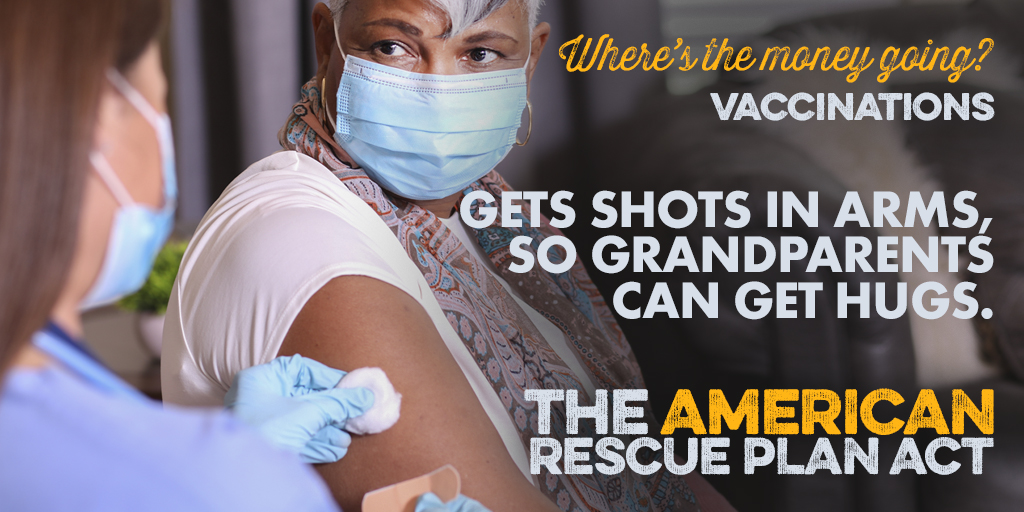
Pension Protection
The American Rescue Plan provides up to $86 billion for struggling multiemployer pension plans, which will directly protect the futures of 120,000 active USW members and retirees. It stabilizes the pension system that has 10 million union members, widows, and retirees.
Approximately 130 multiemployer pensions were in crisis as a result of corporate bankruptcies, previous bad legislative decisions, industry consolidation and investment losses. The coronavirus-led economic crisis exacerbated this problem.
This means hundreds of thousands of hard-working Americans, including USW members, risked losing their retirements through no fault of their own.
The USW has been fighting to help these workers for years. Now, the recovery package, which includes the Butch Lewis Emergency Pension Plan Relief Act of 2021 provides them with peace of mind.
It will shore up struggling plans, ensuring that they are fully funded for at least 30 years. Additionally, it will allow healthy plans to better account for the pandemic and help to ensure their solvency for the future.
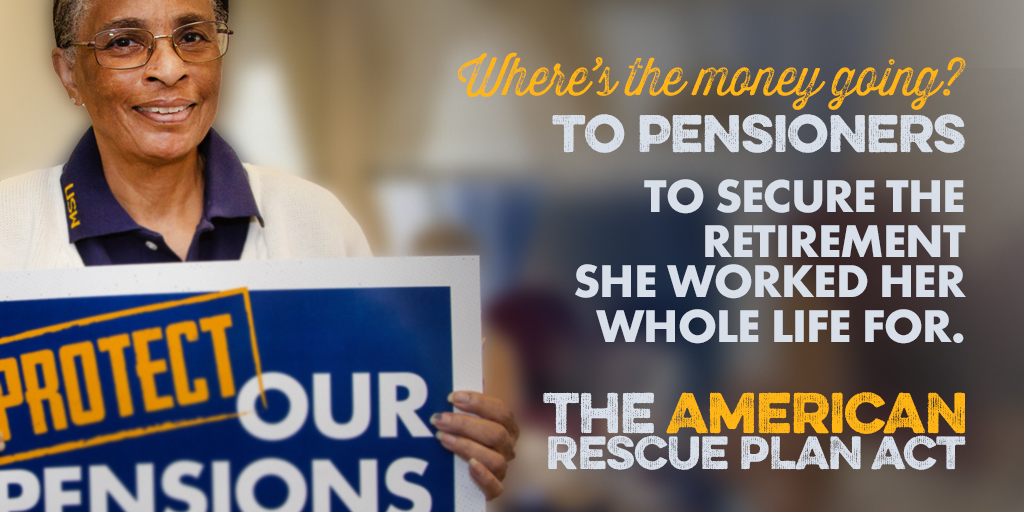
Workplace Safety
The American Rescue Plan grants $150 million for COVID-19 worker protections, with $75 million dedicated to OSHA enforcement in high-risk sectors including those where USW members work. This has been a USW priority since the pandemic began.
We must keep our frontline workers safe as we continue to fight the virus.
Health care and other high-risk workers – including our union siblings – continue to put their lives on the line. It’s not enough to rely on employers to ensure that they’re following health and safety recommendations; there must be accountability and enforcement.
OSHA must have the necessary resources to oversee worker safety, including doing inspections and issuing penalties.
Funds like these will help the union service our members better. Together we will fight for the tools that allow you to go to work safely and earn a decent wage for your family.
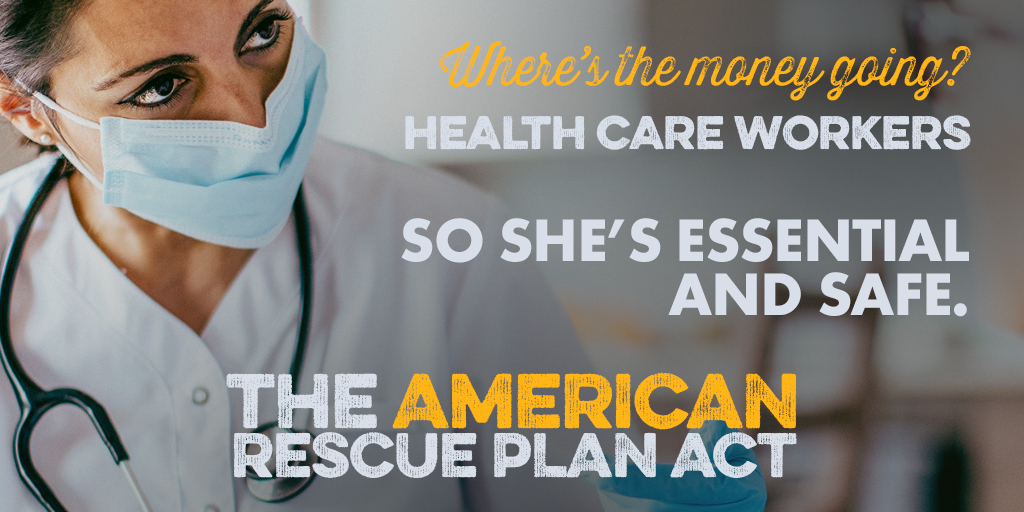
Tax Cuts for Families
Low- and moderate-income households (those making $91,000 or less) will receive nearly 70 percent of the tax benefits from the measure. Families with children will get an average tax cut of more than $6,000 under the bill.
Working families have risked – and lost – the most during this pandemic.
Many workers saw their hours cut or their jobs eliminated as a result of the pandemic. Other families had to scale back to relying on a single wage earner to accommodate limited child care options.
It only makes sense that working families should get the bulk of the benefits.
Relieving the tax burden on workers means they have more to spend on needed goods, helping keep businesses afloat.
Union members with children know the additional expenses associated with raising our future generations. These tax benefits in a time of need will help ensure we provide for individuals who will take care of us.
This comes just in time as past “tax cuts” phase out tax reductions for working people and the poor, while maintaining them for the wealthiest Americans.
Like the direct payments, giving money to working families who will spend it in their communities helps rebuild both local economies and will stimulate job growth.
Unemployment Benefits
The American Rescue Plan includes enhanced unemployment benefits through September, providing an additional $300 per week on top of all state unemployment benefits.
Also included is a provision to waive taxes on the first $10,200 in unemployment income for those who made less than $150,000 in adjusted gross income in 2020. This means so much to the thousands of USW members who were laid off or lost their jobs during the pandemic.
The pandemic affected all Americans, but it impacted each of us differently. While some were able to keep doing their jobs, others had their hours cut or their jobs eliminated. Some two-income households are now relying on a single income.
In February more than 13 million Americans reported that they were unable to work because their employer closed or lost business due to the pandemic.
Many of our USW siblings who work in the service sectors as well as a number in manufacturing (and other industries) are still struggling.
These workers are eager to return to their jobs, but until they can, we must do everything we can to make sure they and their families can meet their basic expenses.
Unemployment benefits provide a short term stability to both those who receive them and the broader community until our economy can truly begin to recover.
Full COBRA Subsidies
The American Rescue Plan extends COBRA coverage for uninsured workers with a 100 percent subsidy; this is vital for many of our Steelworker siblings.
Another devastating consequence of being out of work is that many who lose their jobs face the prospect of also losing their health insurance.
This includes our union siblings who lost their jobs or have been laid off and as a result lost their employer sponsored healthcare. Although being in a union can help members jump through the hoops to get COBRA coverage, that still doesn’t make it affordable. (COBRA gives workers the opportunity to extend their employer sponsored health insurance so they can continue their coverage.)
The middle of a pandemic is perhaps the worst time for working families to be worrying about how they’ll pay for health care. Many of our neighbors right now are quietly focused on survival needs — getting food on the table, paying next month’s rent or mortgage. Even during a pandemic, finding healthcare is not at the top of the list. We need to make that as easy and affordable as possible.
The American Recovery Plan gives them important options.
Example Calculation:
Let’s say you used to have $125 taken from each paycheck for health insurance. You got paid twice per month, so your portion of the monthly premiums was $250.
Your employer contributed $400 per month toward your health insurance premiums, so the total cost of your job-based health plan was $650 per month.
Unfortunately, your company downsizes and you get laid off. You opt for COBRA so you can continue to have health coverage.
The cost is calculated as follows:
$650 a month (total of your and your former employer's premium contributions)
+
2% service charge (in this case, $650 x 0.02, which is $13)
Your total cost for COBRA, therefore, is $663 a month.
This also helps those of us that continue to have health insurance because the cost of those uncovered gets shifted to those with coverage by hospitals struggling to survive in the pandemic. We protect our health care insurance and coverage when we make sure all are covered.
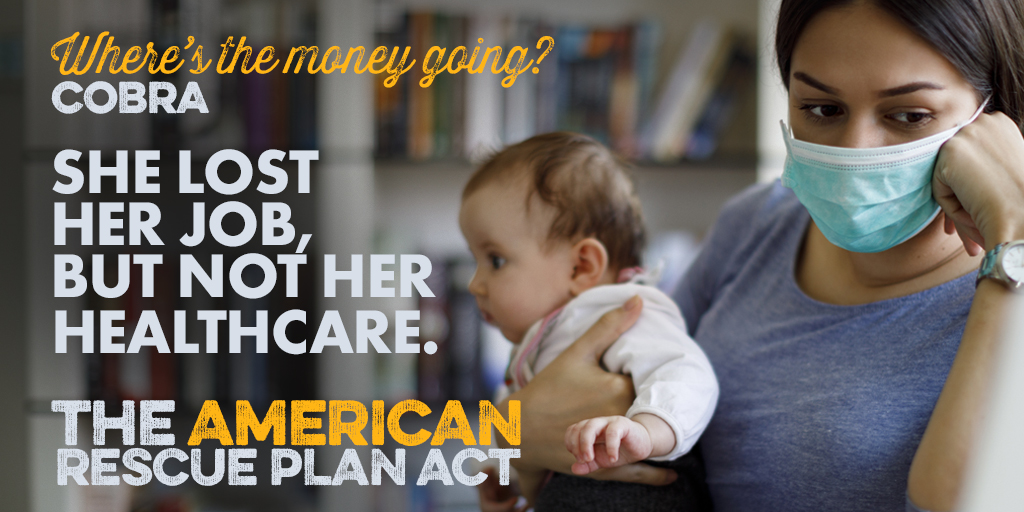
Direct Payments
The American Rescue Plan provides for direct payments of up to $1,400 to Americans who need it the most.
Direct payments help struggling families pay for what they need most right now, whether that’s food, housing, child care, car repairs or other emergency expenses.
As Americans spend this money, it also provides support for the businesses that rely on workers to keep them afloat.
While the already wealthy tend to hoard extra money in bank accounts and the stock market, providing funds to working people who will spend the money helps everyone.
Although some folks have not missed a beat and may not necessarily be counting on that extra money, it can be spent in the community to add a much needed boost to local businesses that are struggling.
This money doesn’t just help individual families and businesses they buy goods from, economic growth relies primarily on consumer demand. These direct payments provide the foundation for future economic prosperity in our communities and job growth as we move forward.

Education
The American Rescue Plan provides for $130 billion to help schools. This funding will allow the CDC’s recommended steps to go forward, ensuring students, educators, and employees, including USW members and our children, can return to the classroom safely.
For many families returning to work means getting children back in school in person, full time. But it’s also essential that we keep educators safe as we do this.
Providing the necessary funds to provide adequate PPE and distancing will keep workers safe as students return, and cuts down on surprise quarantine time for an exposure that impacts or limits the parents’ ability to get to work.
Funds to address learning loss will also help soften the impact the past year had on some children.
The pandemic has exposed huge inequalities in access to high speed internet and at home educational resources in rural areas and in communities of color. While in the longer run, we will need to address this with infrastructure investment, in the short run we need to pay special attention to the children that have suffered most.
The plan also provides funds for child care and head start as well as for higher-ed, so that all students have a chance to get ahead.
Getting kids back to school safely takes the burden of scrambling around childcare needs so parents do not have to miss work.
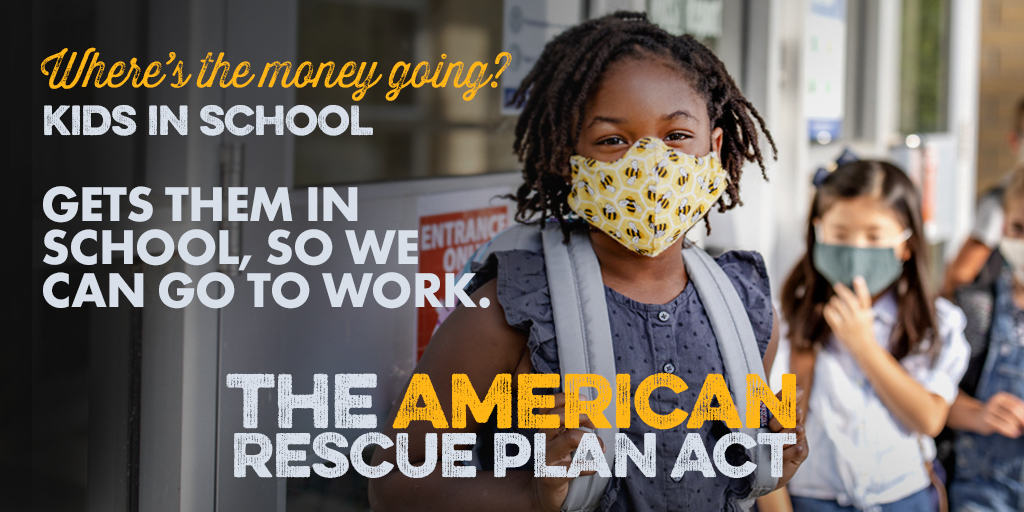
Veterans
The American Rescue Plan provides $386 million to create a rapid retraining program for veterans who are unemployed because of the pandemic.
It also provides health care and mental health services, including enhanced telehealth options, and expanded support for homeless veterans or those in danger of becoming homeless.
To help keep still more veterans safe, it provides funding to state veterans’ homes and provides funding to ensure the VA is able to continue making appointments and providing care.
Thousands of USW members and retirees are veterans, and they and their fellow veterans deserve access to the resources they need when they need it.
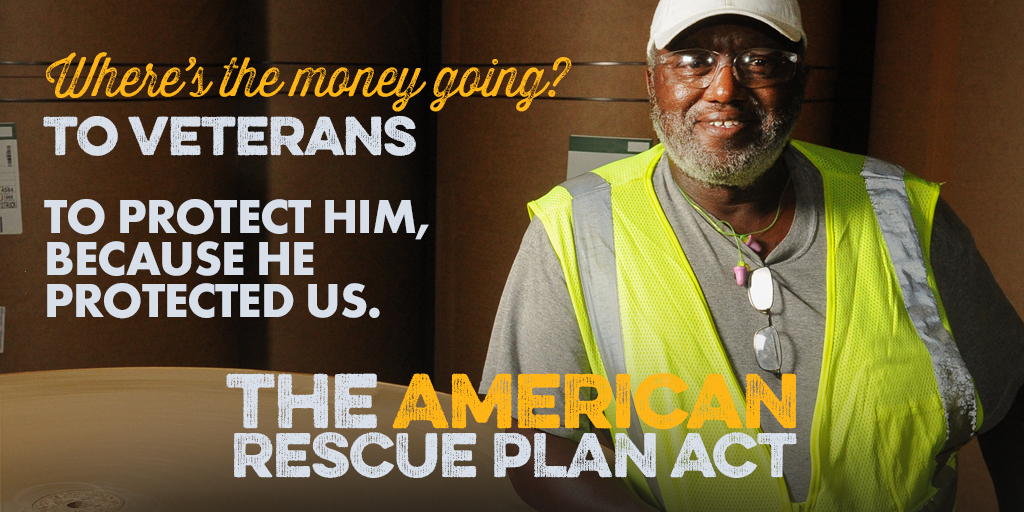
Relief for State and Local Governments
The American Rescue Plan provides $350 billion in aid to state, local, tribal and territorial governments to help deal with the budgetary impact of the pandemic, including $195.3 billion for states and Washington, D.C.; $130.2 billion for local governments; $20 billion for tribal governments; and $4.5 billion for U.S. territories.
- The pandemic created huge, unexpected expenses for state and local governments at the same time that it radically lowered revenue.
- Many smaller cities and counties did not get CARES money.
- This funding will help offset losses and can be used for local economic recovery purposes, including assistance to households, small businesses and nonprofits, assistance to hard-hit industries like tourism, travel, and hospitality, infrastructure investment, and premium pay for essential workers.
- According to the Economic Policy Institute, state and local employment is down 1.4 million since the pandemic began and job losses increased by 50,000 in December.
- The USW includes thousands of members who work for state and local governments. Those who kept their jobs have faced added challenges, as they try to stay safe while continuing to help their communities.
A closer look at the American Rescue Plan
STATE & LOCAL AID
State and local fiscal aid
Who it helps: States, territories, tribes, local governments
What the funding supports:
- $350B to state, local, tribal and territorial governments
- Aid to households, small businesses, non-profits, tourism industries
- Provides premium pay for essential workers
- Provides government services
- To carry out critical infrastructure projects
TAX PROVISIONS
Direct payments
Who it helps: Taxpayers hit hard economically
What the funding supports
- $1,400 Economic Impact Payment to individuals making up to $75,000 and married couples up to $150,000, and for dependents (including adult dependent children)
Earned Income Tax Credit and Child Tax Credit
Who it helps: Individuals, families with children
What the funding supports:
- Triples maximum for EITC
- Increases child tax credit from $2,000 to $3,000 for children over 6 and $3,600 for under 6 through 2021
Dependent care
Who it helps: Families and dependents
What the funding supports:
- Temporarily increases the value of the child and dependent care tax credit, which covers 35% of care expenses of as much as $3,000 for one dependent or $6,000 for two or more dependents.
- Makes the credit refundable.
- Increases the maximum allowable expenses to $8,000 for one dependent and $16,000 for two or more.
- Allows the credit to cover 50% of expenses.
- Begin phasing out the credit at $125,000, instead of $15,000.
Paid leave credit
Who it helps: Employers, workers
What the funding supports:
- Extends and expands emergency paid sick and expanded FMLA tax credits
- Provides payroll tax credits for employers who voluntarily provide paid leave to all employees through Sept. 2021
- Increases the wages covered by the paid family leave credit to $12,000 per worker, from $10,000.
- Covers as many as 60 days of paid family leave for self-employed individuals, instead of 50.
Employee retention tax credit
Who it helps: Businesses, workers
What the funding supports:
- Extends and expands tax credit through Dec. 2021
OTHER TAX CHANGES
Business losses
Who it helps: Noncorporate taxpayers
What the funding supports:
- Extends rules relating to limitations on “excess business losses” for noncorporate taxpayers for one additional year, through 2026
Corporate interest expenses
What the funding supports:
- Eliminates the ability of companies to allocate interest expenses on a worldwide basis beginning in 2021
Executive compensation
What the funding supports:
- Beginning in 2027, the limitation on deducting compensation for publicly traded companies’ five most highly paid executives would be expanded to include the next five additional highly compensated employees
Small business grants exclusion
Who it helps: Small businesses
What the funding supports:
- Advance funds provided through the Small Business Administration’s Economic Injury Disaster Loan program and restaurant grants created by the bill would be excluded from gross income for tax purposes
Third party transactions
What the funding supports:
- Lower the threshold below which third party settlement organizations don’t need to report certain transactions to $600, from $20,000
LABOR PROVISIONS
Unemployment benefits
Who it helps: Unemployed people
What the funding supports:
- Extends extra $300 Federal Pandemic Unemployment Compensation to Sept. 6, 2021
- Extends CARES Act and Families First Act programs to Sept. 6
- First $10,200 of unemployment benefits excluded from certain taxpayers’ adjusted gross income beginning in 2020
Workplace safety
Who it helps: Department of Labor (DOL); workers
What the funding supports:
- $200M for DOL worker protection enforcement activities.
- Half of funds go to OSHA enforcement for high-risk workplaces
- Increases to the Wage and Hour Division, the Office of Workers’ Compensation Programs, the Office of the Solicitor, MSHA, OSHA, and the Office of Inspector General.
Federal employee leave
Who it helps:
What the funding supports: Federal workers
- $570M to create an Emergency Federal Employee Leave Fund to provide up to 15 weeks of emergency paid leave for civilian employees and postal workers
Workers’ compensation
Who it helps: Federal workers
What the funding supports:
- Would establish a presumption that a Covid-19 diagnosis is work-related and authorize benefits, including disability, medical, and survivor benefits, for federal employees
- Would cover workers who contracted Covid-19 during a three-year period starting Jan. 27, 2020
- Would not apply to full or part-time teleworkers
Pension Provisions
Relief for Multiemployer Pensions
Who it helps: Multiemployer pensions
What the funding supports:
- $86B in financial assistance to struggling multiemployer pension plans through Butch Lewis Act
- Plans will not have to repay
- To cover all benefits due through plan year 2051
- No cuts to accrued benefits
Pension smoothing
Who it helps: Multiemployer pensions
What the funding supports:
- Extend and modify “pension smoothing,” which increases the interest rates used to calculate pension fund liabilities, allowing companies to contribute less money to pension plans in the short term
- The contributions are tax deductible, so lower payments would increase taxable income and federal revenue
Other pension provisions
What the funding supports:
- Would set previous funding shortfalls in single-employer plans to zero and extend to 15 years, from seven, the amortization periods for shortfalls beginning in 2021
- The measure would allow plan sponsors to apply the extended period for the 2019, 2020, or 2021 plan years
HEALTH CARE
Medicaid changes
Who it helps: Medicaid recipients
What the funding supports:
- Covid-19 vaccines and treatments would be covered until a year after the pandemic ends at no cost to beneficiaries under Medicaid and the Children’s Health Insurance Program
- The federal medical assistance percentage (FMAP) would be increased to 100% for vaccine costs during that period
- Coverage expansions, including increasing a state’s FMAP by 5 percentage points for two years if it expands Medicaid to cover the newly eligible adult population under the Affordable Care Act
- Would allow states, for five years, to provide full Medicaid benefits to eligible pregnant women for a year after giving birth
- Drug rebates: Would end, in 2024, a cap on the rebate that drug companies provide to Medicaid, which is currently limited to 100% of the average manufacturer price
- DSH funding
Medicare changes
Who it helps: Medicare recipients
What the funding supports:
- Would allow the Centers for Medicare and Medicaid Services to waive a requirement during the pandemic that ambulance services include transportation to a hospital to receive Medicare payments, if they didn’t transport the patient because of Covid-19-related protocols
ACA subsidies
Who it helps: ACA recipients
What the funding supports:
- Would expand the Affordable Care Act’s premium tax credits for health insurance purchased through an exchange
- For 2021 and 2022, the bill would eliminate premiums for individuals at 150% of the FPL or less, and reduce premiums for all other households. It also would make households above 400% of the FPL eligible, with a premium cap of 8.5% of income
- Would allow individuals who receive unemployment compensation in 2021 to qualify for reduced cost-sharing under the ACA
COBRA coverage
Who it helps: COBRA recipients
What the funding supports:
- Subsidizes 100 percent of COBRA premiums for six months for individuals who lost employment or had reduced hours
- Individual wouldn’t have to pay any premiums, and the employer or health plan could claim a refundable tax credit against its Medicare payroll tax liability for the cost of the premiums
Rural health care
Who it helps: Residents in rural areas
What the funding supports:
- Increased vaccine distribution
- Providing medical supplies
- Expand access to telehealth
Health care funding
Who it helps: Health and Human Services Dept.
What the funding supports:
- $47.8B for testing and tracing
- $8.5B for vaccine activities
- $7.66B to expand public health workforce
- $7.6B for community health centers
- $6.09B for tribal health programs
- $6.05B to support manufacturing and purchasing vaccines and therapeutics
- $3B for block grant programs under the Substance Abuse and Mental Health Services Administration.
- $1.75B for genomic sequencing and surveillance.
- $800 million for the health workforce.
- $750M for CDC global health activities.
- $500M for the Food and Drug Administration to continue evaluating Covid-19 vaccines and therapeutics.
- $500M for CDC data modernization and forecasting
Child care and head start
Who it helps: Child care providers, children, families
What the funding supports:
- $24B to child care providers
- Of that, $15B to subsidy program for low-income families
Other HHS programs
What the funding supports:
- $4.5B for the Low Income Home Energy Assistance Program.
- $1.43B for programs under the Older Americans Act, including $750M for nutrition programs.
- $852M for the Corporation for National and Community Service, including $620M for AmeriCorps.
- $450M for programs under the Family Violence Prevention and Services Act, including $198M to support survivors of sexual assault.
- $350M for programs under the Child Abuse Prevention and Treatment Act.
- $50M for the Title X Family Planning Program.
Defense Production Act
Who it helps: Essential workers, all citizens
What the funding supports:
- $10B to expand domestic production of PPE, vaccines, medical supplies
SMALL BUSINESS AID
Small business capital
Who it helps: Small business owners, entrepreneurs
What the funding supports:
- Helps states support small businesses to recover
- Create and retain jobs
Targeted Economic Injury Disaster Loan Grants
Who it helps: Hard-hit, underserved small businesses
What the funding supports:
- $15B for additional advance payments to eligible entities under the SBA’s Economic Injury Disaster Loan (EIDL) program
Restaurants
Who it helps: Restaurant industry
What the funding supports:
- $28.6B grant program in RESTAURANTS Act
Paycheck protection program
Who it helps: Eligible 501(c)(5) labor and agricultural organizations and community locations of larger nonprofits
What the funding supports:
- $7B to expand eligibility of the program to non-profits and organizations doing frontline work
- $250M to expand PPP eligibility for digital news services that provide local news and lifesaving information
State initiative
Who it helps: States, small businesses
What the funding supports:
- $1.5B for states to support businesses owned by socially and economically disadvantaged people.
- $1B for an incentive program to boost funding tranches for states that show robust support for such businesses.
- $500M to support small businesses with fewer than 10 employees.
- Additional $500M for states to provide legal, accounting, and financial advisory services
Other SBA funding
Who it helps: Small businesses
What the funding supports:
- $1.25B for live venues and other cultural institutions
- $840M for Paycheck Protection Program administrative costs
- $390M to administer disaster loan program and $70m for the cost of additional loans
- $100M for the SBA to establish a community navigator pilot program and $75M to promote community navigator program
EDUCATION
K-12 Schools
Who it helps: Children, teachers in public and some non-public schools
What the funding supports:
- $122.8B in state grants to help address learning loss
- $2.75B to support non-public schools
- $3.03B for grants and programming under the Individuals with Disabilities Education Act
- $100M for research on addressing learning loss related to the pandemic
Higher Ed
Who it helps: Colleges, universities and students
What the funding supports:
- $39.6B to colleges and students
- At least half for emergency financial aid to students
- To cover costs of declining enrollment, COVID protocols and online learning
Institute of Museum and Library Services
Who it helps: Libraries and museums
What the funding supports:
- $200M for museum and library administration
National Endowment for the Arts and National Endowment for the Humanities
Who it helps: Arts and culture organizations, workers
What the funding supports:
- $135M to each
TRANSPORTATION
Public transportation
Who it helps: Transit workers, riders
What the funding supports:
- $30.5B in grants to transit agencies
- Layoff prevention
- Construction projects
Airport assistance
Who it helps: Airports
What the funding supports:
- $8B for airport sponsors (owners)
- Airports that receive funding would be required to retain at least 90% of personnel employed as of March 27, 2020, through Sept. 30
Amtrak
Who it helps: Workers, remote communities, riders
What the funding supports:
- $1.7B to restore full long-distance service to remote areas and hire back workers
Airlines and aerospace payroll support
Who it helps: Workers in airports, for airlines, and aerospace manufacturers
What the funding supports:
- $15B for wages and benefits of employees in airline industry
- No layoffs or pay cuts through at least Sept. 30
- $3B to create a payroll support program for aviation manufacturers
FAA and FSA employee leave
Who it helps: FAA and FSA employees
What the funding supports:
- $13M for an Emergency TSA Employee Leave Fund
- $9M for an Emergency FAA Employee Leave Fund
HOUSING
Emergency rental assistance
Who it helps: Low-income families
What the funding supports:
- $21.6B to prevent evictions
Homeowner assistance
Who it helps: Homeowners
What the funding supports:
- $9.96B to establish Homeowner Assistance Fund at the Treasury Dept.
Assistance for people experiencing homelessness
Who it helps: Services assisting people experiencing homelessness
What the funding supports:
- $5B supportive services for homeless
- Socially-distant housing options
Emergency housing vouchers
Who it helps: People experiencing homelessness, at-risk youth, victims of violence and human trafficking
What the funding supports:
- $5B emergency public housing
Rural housing assistance
Who it helps: Rural homeowners, renters
What the funding supports:
- $100M to people living in USDA-subsidized housing who have experienced income loss buy aren’t receiving federal rental aid
AGRICULTURE AND NUTRITION
Supplemental Nutrition Assistance Program (SNAP)
Who it helps: Families, children, and those who need food assistance
What the funding supports:
- Extends the 15% increase in SNAP benefits through September 30, 2021 to address the hunger crisis
- $1.15B to states for SNAP administration
- $1B for grants for nutrition assistance in US territories
- $25M to improve SNAP online technology
Pandemic EBT program
Who it helps: Children, families
What the funding supports:
- Provides families with extra food assistance to help offset the cost of missed school meals
Supplemental Nutrition Program for Women, Infants and Children (WIC)
Who it helps: Mothers, children
What the funding supports:
- $390M for outreach and modernization of WIC.
- $490M to increase Cash Voucher Benefits for WIC recipients
Agriculture Department Emergency Pilot grant program
Who it helps: Rural residents
What the funding supports:
- $500M for an Agriculture Department emergency pilot grant program, supporting organizations providing Covid-19-related services in low-income rural areas
Socially disadvantaged farmers
Who it helps: Socially disadvantaged farmers and ranchers
What the funding supports:
- $1.01B for grants and loans to improve land access for socially disadvantaged farmers, ranchers, and forest landowners
International food aid
Who it helps: Developing countries at risk of hunger and famine
What the funding supports:
- $800M for Commodity Credit Corporation purchases and distribution under the Food for Peace program
VETERANS' AFFAIRS
Health care services
Who it helps: Veterans
What the funding supports:
- $14.5B for health care, which would include as much as $4B for veterans to receive care outside the VA.
- $750M for state veterans’ homes
- $272M for claims and appeals processing
- $100M for supply chain modernization initiatives
Copayments and cost sharing
Who it helps: Veterans
What the funding supports:
- $1B for VA to waive health insurance copayments and cost sharing expenses from April 6,2020 through Sept. 30, 2021
Job training
Who it helps: Veterans who have lost their jobs
What the funding supports:
- $386M to create rapid retraining program for veterans unemployed due to pandemic
Employee leave fund
Who it helps: Staff and veterans
What the funding supports:
- $80M for Emergency Dept. of Veterans Affairs employee leave fund
- Would cover paid leave for VA Health Administration employees who have Covid-19 related concerns
NATIVE SERVICES
Health care services
Who it helps: Indian/Alaska Natives
What the funding supports:
- Provides a 100% FMAP for Medicaid for two years for services received through an Urban Indian Organization or Native Hawaiian Health Center
Education
Who it helps: Native education programs and schools
What the funding supports:
- $850M to the Bureau of Indian Education for support to schools and programs it funds or operates and for tribal colleges and universities
- $190M for grants to educational organizations serving American Indians, Native Hawaiians, and Alaska Natives
Bureau of Indian Affairs
Who it helps: Tribal governments
What the funding supports:
- $772.5M for tribal government services
- $100M for tribal housing improvement
FOREIGN ASSISTANCE & STATE DEPARTMENT
Global health assistance
Who it helps: State Department, USAID, WHO
What the funding supports:
- $3.09B for COVID response and disaster relief
- $3.75B to Global Fund to Fight HIV/AIDS, Tuberculosis and Malaria
- $930M for COVID prevention and response, $905M for USAID global health activities, including a contribution to a multilateral vaccine development partnership.
- $580M for multilateral assistance, including the United Nations’ Global Humanitarian Response Plan for Covid-19
Refugee, displaced persons aid
Who it helps: Refugees
What the funding supports:
- $500M for migration and refugee assistance
OTHER PROVISIONS
FEMA disaster relief
Who it helps: Federal emergency management
What the funding supports:
- $50B for federal emergency management agency’s disaster relief fund to respond to COVID-19
- Financial assistance for pandemic-related funeral expenses
- $510M for FEMA’s Emergency Food and Shelter program
- $300M for FEMA’s firefighter grant programs
- $100M for Emergency Management Performance Grants
Information Technology and Cyber Security
Who it helps: Federal agencies
What the funding supports:
- $1B to upgrade federal agency IT systems
- $650M for Homeland Security to mitigate cybersecurity risks
- $200M for IT support to federal agencies
- $150M to support public access to federal information and services
Broadband for remote learning
Who it helps: Schools, libraries
What the funding supports:
- $7.17B to create Emergency Connectivity Fund
- To cover costs of broadband service to schools and libraries
National Science Foundation
Who it helps: Scientists, researchers
What the funding supports:
- $600M for COVID-related research
Corporation for Public Broadcasting
Who it helps: Public broadcasters and audiences
What the funding supports:
- $175M to maintain services and preserve small and rural stations
National Institute of Standards and Technology
Who it helps: Researchers
What the funding supports:
- $150M to fund research, development and testbeds
Environmental Protection Agency
Who it helps: EPA
What the funding supports:
- $100M for grants that address air quality and environmental harms among minority and low-income populations
U.S. Fish and Wildlife Service
Who it helps: U.S. Fish and Wildlife Service
What the funding supports:
- $95M for wildlife inspections, prevention of wildlife disease outbreak
- Care for captive endangered species
Government Accountability Office
Who it helps: Government Accountability Office
What the funding supports:
- $77M to accountability services
Consumer protection
Who it helps: Safety inspectors, consumers
What the funding supports:
- $50M for additional safety inspectors at US ports of entry during the pandemic
- Focus on products related to COVID
Oversight committee
Who it helps: Pandemic Response Accountability Committee
What the funding supports:
- $40M to oversee use of COVID-19 funds
Customs user fees
What the funding supports:
- Would extend certain customs user fees and rates for merchandise processing fees to Sept. 30, 2030, from Oct. 21, 2029